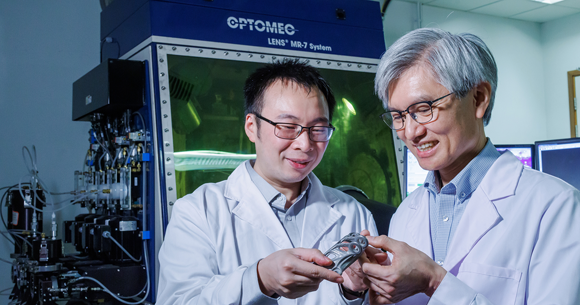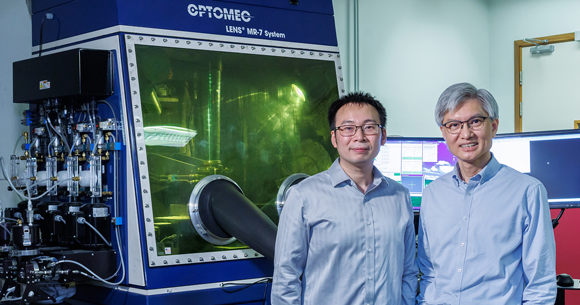PolyU researchers develop new Ti alloy via DED Additive Manufacturing
July 31, 2023

Engineering scientists from the Hong Kong Polytechnic University (PolyU), in collaboration with RMIT University and the University of Sydney, have used Additive Manufacturing to address the quality and waste management challenges faced in titanium alloy production. Their research study, titled “Strong and ductile titanium-oxygen-iron alloys by additive manufacturing,” was recently published in Nature.
The research team has utilised Additive Manufacturing to create a new, strong, ductile, and sustainable alloy, the α–β Ti-O-Fe alloy. These properties are achieved by incorporating inexpensive and abundant oxygen and iron, which are the two most powerful stabilising elements and strengtheners for α–β phase titanium alloys. This new titanium alloy presents potential for diverse applications such as aerospace and marine engineering, consumer electronics, and biomedical devices.
The authors stated, “In terms of AM process selection, we chose laser metal powder Directed Energy Deposition (DED), which — aided by high-fidelity simulations — allows for the fabrication of large-scale near-net-shape components with a consistent microstructure.”
According to reports, the new titanium alloy exhibits better mechanical performance, higher strength, and comparable ductility to the widely used Ti-6AI-4V benchmark material, which was formulated in 1954.
Although traditional manufacturing methods, such as casting, can be used to produce the new titanium alloy, the resulting material may have poor properties that render it unsuitable for practical engineering. Additive Manufacturing, on the other hand, reportedly overcomes these limitations associated with traditional methods of production and improves the properties of the alloy.
The Kroll process, which is typically used to produce titanium alloys, is energy-intensive and generates off-grade sponge titanium. This waste product accounts for approximately 10% of all sponge titanium and results in substantial waste and increased production costs. However, Additive Manufacturing provides an effective solution by enabling the recycling of off-grade sponge titanium. This technology converts the waste into powder for use as raw material, thereby reducing waste and production costs.
Dr Zibin Chen, stated, “Our work can facilitate the recycling of more than 10% of the waste generated by the metal alloy production industry. This can significantly lower both material and energy costs for industries, contributing to environmental sustainability and carbon footprint reduction.”

The research integrates alloy design, computational simulations, and experimental characterisation to explore the Additive Manufacturing process-microstructure-property space for the new titanium alloy (α–β Ti-O-Fe alloy).
The study highlights that Additive Manufacturing allows for the one-step production of complex and functional metal parts, which accelerates product development and reduces costs. Additionally, this technology can fabricate metal parts with unique structures and compositions that traditional methods cannot achieve.
Additive Manufacturing enables the adjustment of the microstructure of metal alloys, improving its strength, flexibility, and resistance to corrosion and water. In addition, it allows for the creation of lightweight yet strong metal parts with intricate patterns. This research breakthrough may present new opportunities for sustainable and holistic material design strategies, facilitated by Additive Manufacturing.
Professor Keith KC Chan concluded, “This work can serve as a model or benchmark for other metal alloys that use 3D printing to enhance their properties and expand their applicability. Metal 3D printing is an emerging field, and it will take time before it is widely adopted in materials manufacturing.”
Download Metal AM magazine

















